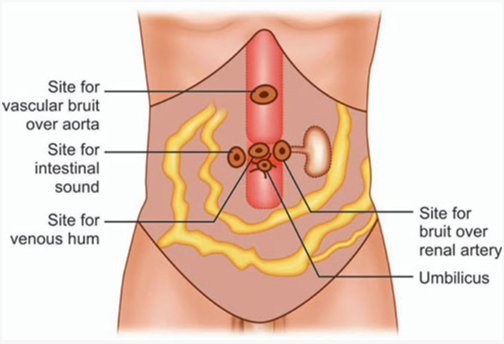The nurse is admitting a client with Abdominal aortic aneurysm. Which assessment data would support the diagnosis?
Shortness of breath.
Abdominal bruit.
Ripping abdominal pain.
Decreased urinary output.
The Correct Answer is B
A bruit is a sound that can be heard with a stethoscope when blood flows through a narrowed or damaged artery. An abdominal bruit may indicate an abdominal aortic aneurysm (AAA), which is a bulge or swelling in the main blood vessel that runs from the heart down through the chest and tummy.
Shortness of breath is a common symptom of many conditions, but it is not specific to AAA. It can be caused by heart or lung problems, anemia, anxiety, lack of exercise, obesity, and many other factors. Shortness of breath may occur with a ruptured AAA, but it is not a reliable sign of an intact AAA.
Ripping abdominal pain is a severe and sudden pain that may indicate a ruptured AAA, which is a life-threatening situation that requires immediate medical attention. However, an intact AAA usually does not cause any pain or discomfort. Therefore, ripping abdominal pain is not a good indicator of an AAA diagnosis.
Decreased urinary output is a sign of reduced kidney function, which can have many causes such as dehydration, kidney failure, urinary tract obstruction, or medication side effects. Decreased urinary output is not directly related to AAA, although it may occur as a complication of a ruptured AAA or surgery to repair an AAA.

Nursing Test Bank
Naxlex Comprehensive Predictor Exams
Related Questions
Correct Answer is ["A","C","D","E"]
Explanation
The questions related to the client's history that are most important to ask are:
How would you describe your symptoms?: This question is important to assess the client's current cardiac symptoms and determine the severity, duration, and nature of their symptoms. It helps the nurse to evaluate the client's cardiac status and determine appropriate interventions.
Are you allergic to any medications or foods?: This question is crucial to identify any potential allergies that could impact the client's cardiac care. It helps the nurse ensure that medications and interventions are safe for the client and prevent any adverse reactions.
How did your mother die?:This question is important to gather information about the client's family history of cardiac diseases and potential risk factors. Understanding the family history helps the nurse assess the client's genetic predisposition to cardiac conditions and plan appropriate interventions and screenings.
Have you had shortness of breath or weight gain? : This question is important to assess for symptoms of heart failure or fluid retention. Shortness of breath and weight gain can indicate fluid accumulation, which is a common symptom in cardiac conditions. It helps the nurse evaluate the client's cardiac function and determine the need for furtherinterventions or medication adjustments.
Let's review the other options and explain why they are not the most important questions to ask:
Do you have any children?: While family history is important, specifically asking about children is not as relevant to the client's current cardiac condition. The focus should be on the client's own symptoms, medical history, and family history of cardiac diseases.
Correct Answer is B
Explanation
Defibrillation is not the first-line treatment for atrial fibrillation. It is used to treat life-threatening cardiac arrhythmias such as ventricular fibrillation or pulseless ventricular tachycardia. Atrial fibrillation, on the other hand, is a rapid and irregular atrial rhythm, and defibrillation is not indicated for its treatment.
Obtain consent for transesophageal echocardiogram (TEE): This is an appropriate action for a client with atrial fibrillation. A TEE is often performed to assess the structure and function of the heart in cases of atrial fibrillation, especially when considering cardioversion or other interventions.
Obtain consent for cardioversion: Cardioversion is a common treatment option for atrial fibrillation, especially when the client is unstable or experiencing symptoms. It involves restoring a normal heart rhythm through the use of electrical shocks or medications. It is important to obtain informed consent before performing cardioversion, but this does not necessarily require questioning.
Hold digoxin 48 hours prior to cardioversion: Digoxin is commonly held before cardioversion because it can increase the risk of certain arrhythmias during the procedure. This is a standard precaution to minimize potential adverse effects. Therefore, the nurse does not need to question this action, as it aligns with established guidelines.
Whether you are a student looking to ace your exams or a practicing nurse seeking to enhance your expertise , our nursing education contents will empower you with the confidence and competence to make a difference in the lives of patients and become a respected leader in the healthcare field.
Visit Naxlex, invest in your future and unlock endless possibilities with our unparalleled nursing education contents today
Report Wrong Answer on the Current Question
Do you disagree with the answer? If yes, what is your expected answer? Explain.
Kindly be descriptive with the issue you are facing.
